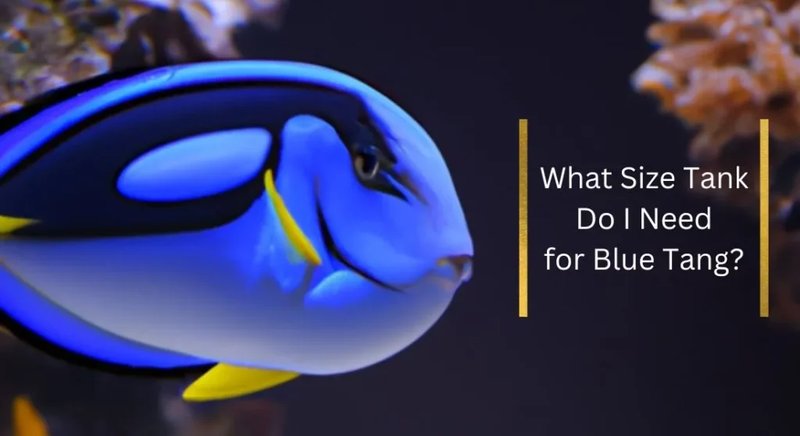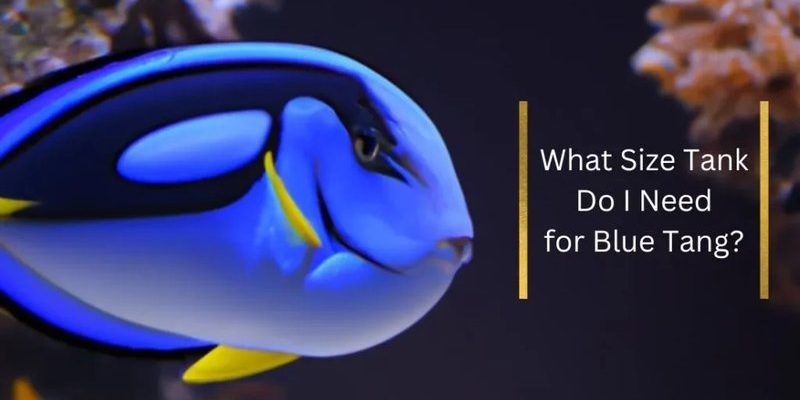
Setting up the perfect environment for your blue tang is akin to creating a safe haven. You wouldn’t want to welcome a guest into a messy room, right? In the same way, your blue tang needs an appropriately sized tank, the right salinity, and a steady temperature to thrive. Let me walk you through these essential requirements so you can give your new fish friend the best life possible.
Tank Size for Blue Tang
When it comes to the tank size, bigger is always better for a blue tang. This species is known for being quite active and can grow up to 12 inches long. Ideally, you should aim for a tank that’s at least 75 gallons. Here’s the deal: a larger tank provides plenty of swimming space and helps maintain water quality, which is super important for the health of your fish.
If you’re wondering why size matters, think about it this way: a small tank is like living in a cramped apartment without any space to move around. Fish can get stressed and even aggressive if they feel confined. By giving your blue tang a spacious home, you’re reducing stress and allowing it to express its natural behaviors, like swimming and foraging.
It’s also a good idea to consider the layout of your tank. You’ll want to decorate it with live rock and possibly some coral, which not only provides hiding spots for your fish but also helps create a more natural environment. Just remember to leave ample open swimming space because blue tangs love to dart around.
Salinity Levels for Blue Tang
Now, let’s talk about salinity—that’s the concentration of salt in the water. For your blue tang, you’re aiming for a salinity level between 1.020 and 1.025 specific gravity. This range mimics their natural ocean habitat where they thrive in saltwater.
Measuring salinity is pretty straightforward with a device called a hydrometer or a refractometer. These tools let you check the salinity levels regularly, ensuring that the water stays within that perfect range. If you’re doing a water change or adding new saltwater, make sure to check the levels before introducing it to your tank.
Here’s the thing: salinity can fluctuate due to evaporation and other factors, so keeping an eye on the levels is crucial. If salinity gets too high or too low, it can lead to stress, illness, or even death for your blue tang. Keeping your fish happy and healthy means monitoring salinity as part of your regular maintenance routine.
Temperature Requirements for Blue Tang
Temperature is another essential factor that contributes to a blue tang’s well-being. These fish thrive in warmer waters, so you should maintain the temperature between 75 to 82°F (24 to 28°C). Having a good quality aquarium heater will help you achieve and sustain that ideal temperature range.
To monitor the temperature, a reliable aquarium thermometer is your best friend. Just like you wouldn’t want to be in an overly hot or cold room, blue tangs also prefer stable temperatures. Rapid fluctuations can be stressful and lead to health issues.
If you’re not sure where to start, many reef aquarists recommend setting your heater a few degrees above the average temperature you want and using a thermometer to set it right. It’s all about finding that sweet spot where your blue tang can feel safe and comfortable, allowing it to flourish in its new home.
Water Quality and Filtration
Water quality cannot be overlooked in your quest for the perfect blue tang tank. These fish are sensitive to changes in their environment, so your tank will need a high-quality filtration system to keep everything clean. Aim for a setup that turns over the entire tank volume at least 3 to 5 times per hour.
Consider using a combination of mechanical, chemical, and biological filtration. Mechanical filters remove debris and particles from the water, while chemical filters can help remove impurities. Biological filtration is essential for breaking down harmful ammonia and nitrites, keeping the water safe for your fish.
Regular water changes—around 10-20% every 1 to 2 weeks—are also important to maintain good water quality. Combine that with monitoring ammonia, nitrite, and nitrate levels with test kits, and you’ll be on your way to providing a safe, healthy environment for your blue tang.
Tank Mates for Blue Tang
If you’re considering a community tank, choosing the right tank mates for your blue tang is key. Blue tangs are generally peaceful fish but can be territorial, especially in smaller spaces. Ideal companions include other docile fish that aren’t overly aggressive or large enough to outcompete them for food.
Some great tank mates for blue tangs might include:
- Clownfish
- Butterflyfish
- Cardinalfish
- Goby species
However, it’s crucial to avoid pairing them with aggressive species like lionfish or larger wrasse, as these can bully or stress your blue tang. When adding new fish to your tank, always allow for a period of acclimation, so they can get used to their new home together without immediate conflict.
Keep in mind that the dynamics of your tank can change over time, so it’s good practice to monitor how all the fish interact. Sometimes, a bit of rearranging in the tank can help reduce territorial disputes.
Feeding Your Blue Tang
Last but definitely not least, let’s cover feeding. Blue tangs are primarily herbivores and thrive on a diet rich in greens. They love to nibble on algae, so offering them dried seaweed or spirulina flakes can be a great way to mimic their natural diet. You might also want to include frozen foods like brine shrimp or mysis shrimp as occasional treats.
Honestly, providing a varied diet is essential for keeping your blue tang healthy. Just like we need a balanced diet to stay in shape, your fish needs the same. If they’re not getting enough fiber or the right nutrients, it could lead to health problems down the road.
You might find it fun to create a “feeding station” by attaching some algae clips to the tank. This not only keeps the food in one place but also lets your blue tang showcase its beautiful colors while munching away.
Final Thoughts
Creating the perfect environment for your blue tang involves understanding a few critical factors: tank size, salinity, temperature, water quality, tank mates, and diet. Each of these elements works together to make sure your blue tang has a long, healthy, and happy life.
Remember, it’s all about providing a space that mimics their natural habitat as much as possible. The more effort you put into setting up your tank correctly, the more rewarding it will be to watch your blue tang thrive. So take your time, do your research, and enjoy the journey of being a fish parent!

